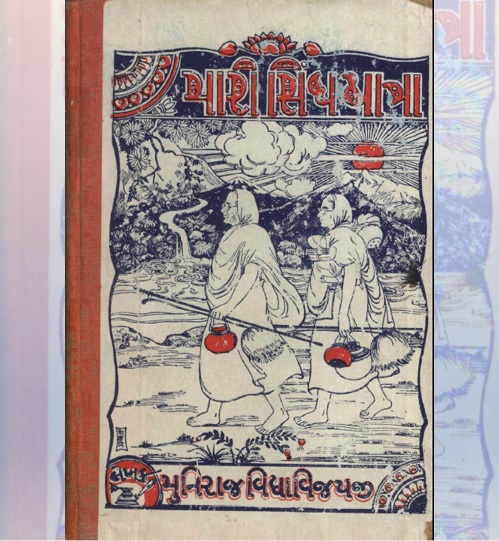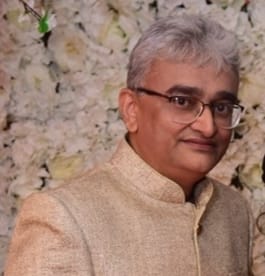
Once we departed from Shivganj it was announced that we are travelling to Sindh. We can divide the journey of about 500 miles from Shivganj to Karachi into many parts, considering the variety of customs, costumes, languages, and lifestyles
[Editor’s Note: This is Part 09 (Marwad and Entering Sindh) of a series of articles based on a pre-partition book named “મારી સિંધ યાત્રા” (“منهنجي سنڌ جو سفر”) in Gujarati authored by Jain sadhu Shri Vidyavijayji, narrating his experiences of travel and stay in Karachi for about 2 and a half years between 1937 and 1939. It would be advisable to click on Introductory Article and read it for a better understanding of the series. – Nasir Aijaz, Editor Sindh Courier]
Vimal Shah, Mumbai
We can divide the journey of about 500 miles from Shivganj to Karachi into many parts, considering the variety of customs, costumes, languages, and lifestyles. In line with the famous quote, ‘The dialect changes after every 12 gau (villages)’, after covering each small unit our entire journey we were getting to see and know new things. With this view, it can be divided into many parts, but I would like to divide our journey into – Shivganj to Balotra – which is particularly known as the Marwadi region, Balotra to Munabao – which includes Badmer and popularly known as Malani region, Munabao to Mirpurkhas – which is known as Ghat and Naar, Mirpurkhas to Hala, Hala to Hyderabad, and Hyderabad to Karachi.
Surprised People
Once we departed from Shivganj it was announced that we are travelling to Sindh. The people of Marwad, mainly inhibited in villages used to get surprised knowing about our journey to Sindh. There’s no wonder if they get astonished hearing the names of Sindh and Karachi, since Sadhus are rarely seen even in their small villages of Marwad.
[Vimal Shah: I am taking the liberty to skip narration of the experience during the journey from Shivganj to Takhat Gadh, Umedpur, Jalore, Sivana, Nakoda, Balotra and few other descriptions which I feel may not be of interest to the readers of SindhCourier.com]
Deserts
Once you cross Umedpur you start seeing sands, more and more sands after Jalore, and almost desert land starts after Balotra. If you happen to drop your clothes, hundreds of thorns would stick to it and if you try to remove them, you end up pricking your fingers with several of them. At some places, your legs would sink so much in the sands that you would exhaust walking just about a furlong. It becomes very difficult to walk in the sands for people who do not have such an experience.
We departed from Balotra on Sunday, 21st of February 1937, the 11th day of the Shukla Paksha of the Magha month.
Malani Pargana
Malani is a district of Marwad. Tilwada is the first station after Balotra. The region from Tilwada right up to Khokhrapar is known as ‘Malani’. Earlier this region was controlled by the Government, now it is under the Jodhpur state. Let’s see why it is known as ‘Malani’?”
Raja Viramde the king of Jodhpur and Mallinath were brothers. Mallinath was a high-souled person. His original name was Malaji. The name of this Pargana ‘Malani’ is derived from his original name. This region used the grammar rule of suffixing ‘ani’. The name of the father or for that matter anyone is suffixed with ‘ani’ while introducing them. If Amolakhchandji’s father’s name is Bhoja, then he would be known as ‘Amolakhchandji Bhojani’. If Virpal’s father’s name is Khetaji, then he would be known as ‘Virpal Khetani’. Likewise, the region of ‘Malaji’ would be known as ‘Malani’. This district was handed over to Malaji and he became a sadhu, a high-souled person, but the identity of the region remained as ‘Malani’. A samadhi-mandir (tomb) of this sadhu has been built in Tilwada. A fair is held there from the 11th day of the Krishna Paksha of Falgun up to the 11th day of the Shukla Paksha of Chaitra. It is predominantly a cattle fair. Many miraculous stories of Malaji alias Mallinathji are popular in the region.
The People of Malani
A poet has nicely narrated the situation in this Duhā (a two-liner poetic composition):
Pēdala bēnhana bhūśayana, pīvana khārāṁ pāṇī,
pēraṇa phāṭā kāpaḍā, yē hai dēśa mālaṇī
The Duhā above gives a glimpse of the nature of the people of Malani. The population in the Malani Pargana is very scattered. Umbrella-shaped round huts made of clay and grass with round walls made of clay and wooden sticks, and only one door for entry and exit. Such houses are known as ‘Ḍhāṇī’ (ڌني). To know the state of Thakors in this Pargana:
Ṭhākōra mana kē ṭhāṭalē, manamēṁ hī rākhē ṭhāṭha,
gharamēṁ cādara ēka hai, ōḍhanavālē āṭha
These two liners are sufficient. This is the perfect description of having hollowness hidden with a layer of gaudiness. Jodhpur state has facilitated the people of this region by carving out sand mountains and a laying the railway line.
The Population of Malani
This ‘Malani’ is said to be a big Pargana in the Jodhpur State. There are 550 villages in this Pargana. It is said that only one village amongst them is inhibited by Khalsa and the rest with Jagirdars. There are in all about 300 to 325 Jagirdars. Five of them are big Jagirdars. The Jagirdars do not have any revenue collection and policing powers. The revenue collection and policing powers rest with the Jodhpur state. The total population of the entire region is 1, 78,438.
The Population of Jains
There are 214 villages amongst them are inhibited by Jains to some extent. Particularly, the population of Jains is more in – Vishala, Butwala, Chauhtan, Chosira, Seenkari, Dhorimanna, Jasai, Jasol, Ramsar, Chanigaon, Seehani, Tapra, Tilwada, Untaka and Badmer. As per the last census, the population of Jains is 6,368 in the entire Pargana. All of them are ‘Shwetambar’, there are no ‘Digambars’ at all.
[Vimal Shah: Jains are divided into two major sects; the ‘Digambara’ (meaning sky-clad) sect and the ‘Śvētāmbara’ (meaning white-clad) sect. ‘Pālītāṇā’ mentioned in the paragraph below is one of the holiest and most significant Tirth (pilgrimage) for Jains.]
They respect the sadhus of every sect. Live in ‘Dhanis’ (huts) in the jungles and keep their faith of Jainism alive by reciting the Navkar Mantra once or twice a day
The Lifestyle of Jains
The people of this region are uncivilized, illiterate, and living a barbaric life. No one can identify a person whether he belongs to the Baniya or any other community. We were lodging in the Musafirkhana of the Baytu station. One person came and sat in front of me. Tall muscular body, terrible red eyes, thick and dirty clothes as if he has just dug a mine and came, the dhoti folded above the knees. Came to know from the conversation that he is a resident of Badewa village surrounded by sand mounds and about forty miles from Badmer, and he is a Jain. He said, ‘I am the only one from our village who visited ‘Palitana’ and saw sadhus like you there, so I felt you must be our guru.’ I was astonished to know that ‘he is a Jain’. I called the other sadhus and the volunteers accompanying me and introduced him saying ‘This man is a Jain’. The poor guy could not express but I felt he must be thinking ‘Why would these people have gathered to see me?’. He described his and surrounding villages. His name was Samedo. He introduced himself ‘I used to wander with weapons in Jungles along with Rajputs and indulge in all the activities that they used to do. I left that after getting married.’ Who knows how many followers of Mahavir would be living in the valleys of sand mounds? I asked him to recite the Navkar Mantra. He recited but he was very imprecise in the pronunciations.
[Vimal Shah: The ‘Navakāra Mantra’ or ‘Ṇamōkāra Mantra’ is the most significant mantra in Jainism and one of the oldest mantras in continuous practice.]
Jains operate shops on some of the stations in the region. Living in such places, what religious knowledge would these poor people gain? With a lot of faith, they believe ‘We are Jains, we believe in idol worshipping, our forefathers have built temples and installed idols in them.’ They respect the sadhus of every sect. Live in ‘Dhanis’ (huts) in the jungles and keep their faith of Jainism alive by reciting the Navkar Mantra once or twice a day. (Continues – The 10th part can be read on Sunday May 14, 2023)
Click here for Part-I, Part-II, Part-III, Part-IV, Part-V , Part-VI , Part-VII , Part-VIII
_______________
About the contributor of the series of Articles based on the book
 Vimal Shah is a follower of Jainism by birth and is based in Mumbai, India. He is a Computer Engineer and holds a Diploma in Jainology from Mumbai University. He has immense interest in reading, writing, studying, and teaching Jain Philosophical subjects. He conducts classroom as well as on-line sessions on Jain Philosophical courses. He has created several power point presentations with animation which he uses while teaching and has participated in several Jain Community events to present and explain the relevant subjects to the visiting audience. He has significantly contributed to the translation, reviewing, and editing of the set of books ‘Compendium of Jainism’ of JAINA, USA from English to Gujarati – an initiative of the JAINA India Foundation. He is also associated with a Project for the translation of Jain Aagams (Scriptures) from Gujarati to English and continues to study various subjects and remains a student of Jain Philosophy. He has a special interest in the history and preservation of the Jain Heritage in Pakistan, and is associated with the Jain Heritage Foundation, New Delhi.
Vimal Shah is a follower of Jainism by birth and is based in Mumbai, India. He is a Computer Engineer and holds a Diploma in Jainology from Mumbai University. He has immense interest in reading, writing, studying, and teaching Jain Philosophical subjects. He conducts classroom as well as on-line sessions on Jain Philosophical courses. He has created several power point presentations with animation which he uses while teaching and has participated in several Jain Community events to present and explain the relevant subjects to the visiting audience. He has significantly contributed to the translation, reviewing, and editing of the set of books ‘Compendium of Jainism’ of JAINA, USA from English to Gujarati – an initiative of the JAINA India Foundation. He is also associated with a Project for the translation of Jain Aagams (Scriptures) from Gujarati to English and continues to study various subjects and remains a student of Jain Philosophy. He has a special interest in the history and preservation of the Jain Heritage in Pakistan, and is associated with the Jain Heritage Foundation, New Delhi.